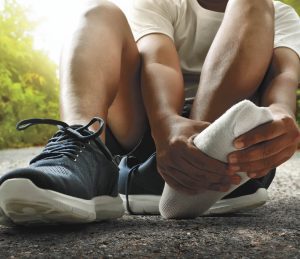By Joe Altepeter, DPM


An alternate scenario, you recall a sudden discomfort which promptly goes away, days or weeks later you notice a stain on your sock, an angry looking spot on your foot, and think to yourself “I stepped on something sinister the other day?”
These events may ultimately result in a puncture wound to the bottom of the foot. Sometimes these puncture wounds can leave a portion of the foreign object in or under the skin. If able to remove any foreign object, then you may have avoided further consequences of the injury. For those with residual foreign material in the skin, those with poor sensation in the foot, or those who endured an injury from a dirty object, there may be more to be concerned about. Prompt assessment in these instances will certainly be important for a good outcome, but may be helpful even if the object was completely removed.
Anyone who experiences a puncture wound should seek medical attention. Some particularly concerning changes that should prompt early presentation to a podiatrist or other member of your health care team would include open sores, purulence or pus, bleeding or drainage, pain or discomfort, redness localized or tracking, swelling, difficulty putting weight on the foot, or visualization of the object.
A visit with your podiatrist will include a review of current and past medical history, and thorough assessment of the problem at hand (or foot). Oftentimes obtaining radiographs, or x-rays, is an important step to rule in or out the presence of any retained foreign body. Some materials however do not show well on radiographs and advanced imaging may be necessary to identify and localize the object. If the object is visible or close to the skin, it could potentially be removed in the office, but it it is more embedded or involves considerable infection, surgery may be indicated. Antibiotics can be important, so testing for bacteria with a culture swab may be performed as well to help guide antibiotics. In the event of a particularly dirty puncture wound, an updated tetanus vaccination may be indicated.
The best way to treat a puncture wound is to not have one in the first place. The best odds of doing that comes with wearing the appropriate shoegear for the task at hand…water shoes at the beach or in the lake, work boots on the job site, house shoes around the house. This is especially important for those dealing with numbness or loss of sensation to their feet. Even when wearing appropriate shoes, these injuries can happen. So do not be ashamed to ask for some advice on treatment.
Disclaimer: This content is not intended to be a substitute for professional medical advice, diagnosis, or treatment. Always seek the advice of your physician or other qualified health care provider with any questions you may have regarding a medical condition.
Joe Altepeter, DPM, AACFAS, is a Podiatrist at Family Foot & Leg Centers in Fort Myers FL. He is a Fellow of the American College of Foot & Ankle Surgeons.
Call 239-430-3668 or visit www.NaplesPodiatrist.com to make an appointment.
Visit FootHealthFacts.org to learn more about foot and ankle conditions.
1645 Colonial Blvd.
Fort Myers, FL 33907
(239) 430 – 3668 (FOOT)
www.NaplesPodiatrist.com
 Southwest Florida's Health and Wellness Magazine Health and Wellness Articles
Southwest Florida's Health and Wellness Magazine Health and Wellness Articles

